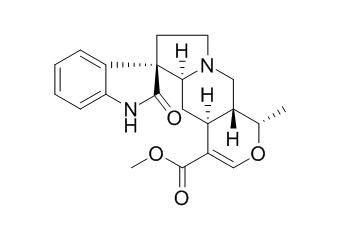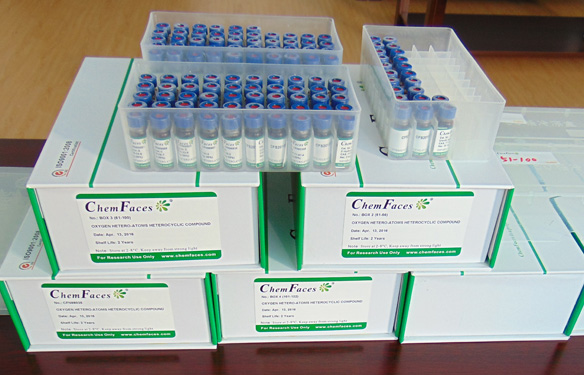Mitraphylline
Mitraphylline has antiproliferative effects on human glioma and neuroblastoma cell lines. It also has anti-inflammatory activity, it inhibits lipopolysaccharide-mediated activation of primary human neutrophils.
Inquire / Order:
manager@chemfaces.com
Technical Inquiries:
service@chemfaces.com
Tel:
+86-27-84237783
Fax:
+86-27-84254680
Address:
1 Building, No. 83, CheCheng Rd., Wuhan Economic and Technological Development Zone, Wuhan, Hubei 430056, PRC
Providing storage is as stated on the product vial and the vial is kept tightly sealed, the product can be stored for up to
24 months(2-8C).
Wherever possible, you should prepare and use solutions on the same day. However, if you need to make up stock solutions in advance, we recommend that you store the solution as aliquots in tightly sealed vials at -20C. Generally, these will be useable for up to two weeks. Before use, and prior to opening the vial we recommend that you allow your product to equilibrate to room temperature for at least 1 hour.
Need more advice on solubility, usage and handling? Please email to: service@chemfaces.com
The packaging of the product may have turned upside down during transportation, resulting in the natural compounds adhering to the neck or cap of the vial. take the vial out of its packaging and gently shake to let the compounds fall to the bottom of the vial. for liquid products, centrifuge at 200-500 RPM to gather the liquid at the bottom of the vial. try to avoid loss or contamination during handling.
Current Analytical Chemistry2024, 20(8):599-610.
J Biol Chem.2014, 289(3):1723-31
Br J Pharmacol.2018, 175(6):902-923
Int Immunopharmacol.2021, 100:108073.
Pharmaceuticals (Basel).2024, 17(9):1130.
J Pharm Biomed Anal.2018, 151:32-41
Cardiovasc Toxicol.2021, 21(11):947-963.
J Traditional Thai Medical Res.2022, 8(1):pp1-14.
Front Pharmacol.2022, 13:870553.
Process Biochemistry2019, 85:106-115
Related and Featured Products
Biotechnol Lett. 2013 May;35(5):791-7.
Differential alkaloid profile in Uncaria tomentosa micropropagated plantlets and root cultures.[Pubmed:
23296316 ]
METHODS AND RESULTS:
The alkaloids of Uncaria tomentosa micropropagated plantlets and root cultures were isolated and identified by NMR and mass spectrometry. Plantlets yielded pteropodine (1), isopteropodine (2), Mitraphylline (3), isoMitraphylline (4), uncarine F (5), speciophylline (6), rhynchophylline (7) and isorhynchophylline (8). In plantlets growing under continuous light, tetracyclic alkaloids 7 and 8 decreased from 20 ± 1.8 at 2 months to 2.2 ± 0.33 mg/g dry wt at 6 months, while the pentacyclic alkaloids 1-4 increased from 7.7 ± 1.4 to 15 ± 0.05 mg/g dry wt, supporting their biogenetic conversion. Micropropagated plantlets produced four times more alkaloids (27.6 ± 3.1 mg/g dry wt) than greenhouse plants.
CONCLUSIONS:
Plantlet roots yielded 3, 4, 8 and the glucoindole alkaloids 3α-dihydrocadambine (9) and dolichantoside (10), the last one not previously found in Uncaria.
J Ethnopharmacol. 2012 Oct 11;143(3):801-4.
Anti-inflammatory activity of Mitraphylline isolated from Uncaria tomentosa bark.[Pubmed:
22846434 ]
Uncaria tomentosa (Willd. ex Roem. & Schult.) DC. (Rubiaceae) is widely used by populations living in South America to treat many ailments associated with inflammatory disorders. Mitraphylline was shown to be the major pentacyclic oxindolic alkaloid present in the bark chloroformic extract of this plant. Its activity against cytokines involved in inflammation process was tested in a murine model in vivo.
METHODS AND RESULTS:
Mice received Mitraphylline once a day for 3 days at 30 mg/kg/day by oral route. Then, they were subjected to bacterial lipopolysaccharide (LPS) endotoxin (15 mg/kg) and the LPS-induced production of 16 different cytokines was determined by Elisa multiplex. Control group received dexamethasone orally at 2mg/kg/day. Toxicity on K565 cells and murine peritoneal macrophages, in vitro, at doses up to 100 μM was monitored by XTT-colorimetric assay.
METHODS AND RESULTS:
For the first time Mitraphylline was tested in vivo against a large range of cytokines that play a crucial role in inflammation.
Mitraphylline inhibited around 50% of the release of interleukins 1α, 1β, 17, and TNF-α. This activity was similar to dexamethasone.
It also reduced almost 40% of the production of interleukin 4 (IL-4) while the corticoid did not. Lastly it did not show any toxicity on K565 cells nor murine macrophages at doses up to 100 μM.
Phytomedicine. 2016 Feb 15;23(2):141-8.
Mitraphylline inhibits lipopolysaccharide-mediated activation of primary human neutrophils.[Pubmed:
26926175]
Mitraphylline (MTP) is the major pentacyclic oxindolic alkaloid presented in Uncaria tomentosa. It has traditionally been used to treat disorders including arthritis, heart disease, cancer, and other inflammatory diseases. However, the specific role of MTP is still not clear, with more comprehensivestudies, our understanding of this ancient herbal medicine will continue growing. Some studies provided its ability to inhibit proinflamatory cytokines, such as TNF-α, through NF-κB-dependent mechanism. TNF-α primes neutrophils and modulates phagocytic and oxidative burst activities in inflammatory processes. Since, neutrophils represent the most abundant pool of leukocytes in human blood and play a crucial role in inflammation, we aimed to determine the ability of MTP to modulate neutrophil activation and differentially regulate inflammatory-related cytokines.
METHODS AND RESULTS:
To determine the mechanism of action of MTP, we investigated the effects on LPS-activated human primary neutrophils responses including activation surface markers by FACS and the expression of inflammatory cytokines, measured by real time PCR and ELISA. Treatment with MTP reduced the LPS-dependent activation effects. Activated neutrophils (CD16(+)CD62L(-)) diminished after MTP administration. Moreover, proinflamatory cytokines (TNF-α, IL-6 or IL-8) expression and secretion were concomitantly reduced, similar to basal control conditions.
CONCLUSIONS:
Taken together, our results demonstrate that MTP is able to elicit an anti-inflammatory response that modulates neutrophil activation contributing to the attenuation of inflammatory episodes. Further studies are need to characterize the mechanism by which MTP can affect this pathway that could provide a means to develop MTP as new candidate for inflammatory disease therapies.
Phytomedicine. 2007 Apr;14(4):280-4.
Antiproliferative effects of mitraphylline, a pentacyclic oxindole alkaloid of Uncaria tomentosa on human glioma and neuroblastoma cell lines.[Pubmed:
17296291 ]
Uncaria tomentosa inner bark extract is a popular plant remedy used in folk medicine to treat tumor and inflammatory processes.
METHODS AND RESULTS:
In this study, the anti-tumoral effects of its pentacyclic alkaloid Mitraphylline were investigated. Furthermore, its growth-inhibitory and cytotoxic effects on glioma GAMG and neuroblastoma SKN-BE(2) cell lines were studied using cyclophosphamide and vincristine as controls. A colter counter was used to determine viable cell numbers, followed by application of the tetrazolium compound [3-(4,5-dimethylthiazol-2-yl)-5-(3-carboxymethoxyphenyl)2-(4-sulfophenyl)-2H-tetrazolium], inner salt, colorimetric method to evaluate cell viability in this cytotoxicity assay. Micromolar concentrations of Mitraphylline (from 5 to 40 microM) inhibited the growth of both cell lines. It inhibited the growth of the two cell lines studied in a dose-dependent manner. The IC(50) values were 12.3 microM (30h) for SKN-BE(2) and 20 microM (48 h) for GAMG, respectively.
CONCLUSIONS:
This action suggests that Mitraphylline is a new and promising agent in the treatment of human neuroblastoma and glioma.



